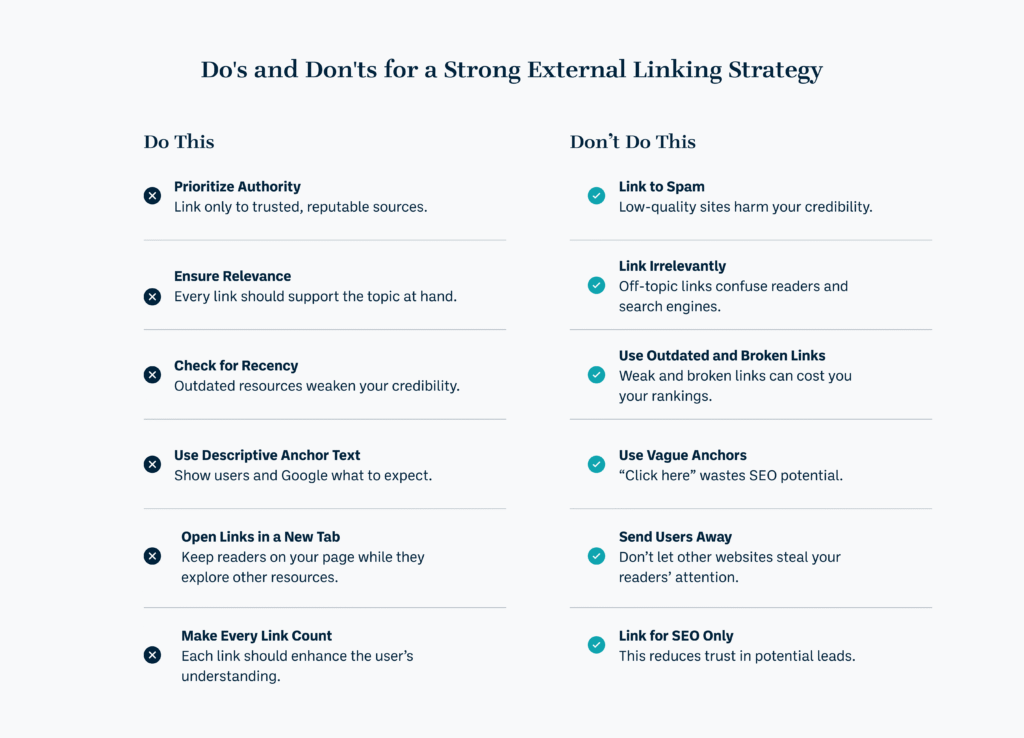
In B2B marketing, credibility is currency. But in a world full of content, how do you prove you know what you’re talking about?
While most SEO strategies focus on keywords and backlinks, they often miss a simple, powerful tactic: external linking. It may feel counterintuitive to send visitors away, but when used strategically, external links can transform your content from a simple post into a trusted authority.
This guide will show you how to master external linking for SEO and build trust without leaking traffic.
Key Takeaways
- External links are a critical trust signal. They act as academic citations, proving to both readers and Google that your content is well-researched and backed by credible sources.
- Your content’s credibility is tied to your sources. By linking to authoritative domains, you borrow their trust and position your brand as a part of a reliable conversation, boosting your own rankings in the process.
- A strategic approach solves the “traffic leak” problem. The right tactics, like opening links in new tabs and providing context, ensure external links add value for the reader without costing you a page view.
- Effective linking is a vetting process. It’s about checking for authority, relevance, and recency, and avoiding common pitfalls like linking to low-quality or outdated resources.
- External linking is a trust multiplier. This isn’t merely an SEO tactic, but also a way to build a reputation that can lead to partnerships and a steady flow of backlinks.
What Is an External Link?
An external link (also called an outbound link) is any hyperlink that directs from your website to another domain. For example, if a cybersecurity consultancy cites a Gartner report and links to it, that’s an external link.
The most common question B2B leaders ask is, “Why should I send readers away?”
The answer lies in the very nature of trust. When your insights are backed by a credible third party, your readers and search engines are far more likely to take you seriously.
External Links vs. Internal Links: What’s the Difference?
These two types of links serve different, but equally important, purposes.
- External Links are links you create from your site to another site. They signal that you’re referencing authoritative sources and adding value for your readers.
- Internal Links are links that connect one page on your site to another page on your site. They help users navigate and signal to search engines which pages are most important.
What Is External Linking in SEO?
From an SEO perspective, external linking is crucial for demonstrating your expertise and trustworthiness. They show Google’s algorithms that you aren’t creating content in isolation but are building on established knowledge. This ties directly into Google’s E-E-A-T framework: Experience, Expertise, Authoritativeness, and Trustworthiness.
In short, external linking is about giving both readers and search engines confidence that your content is accurate, reliable, and backed by authoritative references.
Why External Linking for SEO Matters
External linking has benefits on multiple levels, impacting both your human audience and search engine algorithms.
- Stronger Credibility and Trust: Citing trusted sources makes your arguments more persuasive. This is critical in the B2B world, where senior decision-makers expect evidence-based content.
- Improved Search Rankings: Studies have shown a strong correlation between pages with high-quality external links and higher search rankings. Search engines view these pages as more comprehensive and helpful resources.
- Better User Experience: External links allow readers to go deeper on a topic. If your SaaS blog links to a detailed UX benchmark report, you’re adding value by providing a complete picture rather than keeping users confined to your site.
- Fostered Relationships and Reciprocal Links: Linking to another company’s research or a thought leader’s work can open doors to new collaborations, partnerships, or even reciprocal backlinks, a key driver of SEO success.
How to Build External Links for SEO: Your Smart Linking Checklist
Many B2B leaders hold back from external linking due to a fear of losing traffic or boosting competitors. However, with the right strategy, these fears become non-issues.
Here’s your go-to checklist for incorporating external links into your content, ensuring each one adds value without risk.

1. Prioritize Authoritative Sources
The most important rule is to link to high-quality domains. For B2B, this means research firms (Forrester, McKinsey), reputable news outlets, or government/industry bodies. Avoid low-quality blogs, outdated resources, or spammy sites, as linking to them can hurt your credibility.
📌 Tip: Use SEO tools like Ahrefs, Semrush, or SE Ranking to check the Authority Score or Domain Rating of a site. Prioritize linking to domains with a score higher than your own.
2. Ensure Relevance
Authority means little if the content you’re linking to isn’t directly relevant to your topic. Search engines (and readers) are quick to pick up when a link feels off-topic or forced. Always ask: Does this resource expand on, validate, or provide context for the point I’m making?
📌 Tip: Keep your linking aligned with the user’s intent. If someone lands on your page expecting insights on SaaS pricing models, make sure your external links stay tightly connected to SaaS, tech, or B2B strategy, not off-topic or unrelated resources.
3. Check for Recency and Accessibility
A link to a 10-year-old report on a fast-changing topic like cloud computing isn’t helpful. Always check the publication date to ensure the information is current. You should also ensure the content is easily accessible to readers without a paywall, as this creates a frustrating user experience.
4. Use Descriptive Anchor Text
Anchor text is the clickable word or phrase you link from. Instead of generic phrases like “click here,” use descriptive text that tells the reader what they’re about to see, such as “PwC’s 2023 digital transformation survey.” This provides more context for both users and search engines.
5. Open Links in a New Tab
This is a simple but effective tactic. By setting an external link to open in a new browser tab, you allow readers to explore the resource without leaving your page, keeping your site readily accessible and avoiding a frustrating user experience.
6. Make Every Link Count
There’s no magic number, but a good rule of thumb is to think about quality over quantity. One link to a Gartner report can outweigh ten links to random blogs. A typical blog post might have 2-3 external links and 5-7 internal links, ensuring you both build external authority and keep users navigating within your own site.
📌 Tip: Make it a habit to audit your external links regularly. Use a tool like Screaming Frog to check for broken or outdated links that can frustrate users and harm your SEO.
Advanced Strategies for Maximum SEO Value
Once you’ve mastered the basics, you can take your external linking further with these advanced tactics:
- Build Relationships Through Linking: When you cite a thought leader or partner site, let them know. This simple act can spark collaboration, social shares, or future backlinks.
- Fact-Check AI-Generated Content: If you use AI tools like Gemini or ChatGPT to find sources, always fact-check the claims and links. AI models can sometimes hallucinate or misattribute information. Always read the source material to ensure the quote, statistic, or claim is accurate.
- Blend Internal and External Links: After an outbound reference, guide readers to a related piece of your content using an internal link. This keeps them on your site and deepens their engagement with your content.
Measuring the Impact of External Linking
While external linking doesn’t directly boost your domain authority, its indirect impact is measurable. Here’s what to track:
- Organic Traffic Growth: Use Google Analytics 4 to monitor if the pages with external links are attracting more organic traffic over time.
- Keyword Rankings: Tools like Ahrefs or Semrush can show if your articles are ranking higher for their target keywords after you’ve added authoritative links.
- Dwell Time and Bounce Rate: Check these metrics in Google Analytics to see if readers are spending more time on your pages and are less likely to leave quickly.
- Backlinks Earned: Are other people citing your work in return? This indicates that your well-researched, externally linked content is seen as a valuable resource.
For B2B firms, the ultimate measure is the content’s role in lead generation. If a well-cited article drives form fills or demo requests, your external linking is successfully supporting your pipeline, not just your SEO.
The Bottom Line: External Links are a Trust Multiplier
For B2B companies, SEO is less about visibility and more about becoming a reliable source in your industry. External linking for SEO is one of the simplest yet most overlooked ways to achieve this. By citing authoritative sources, you show both Google and your readers that your content is credible, well-researched, and worth engaging with. Done poorly, external links can feel like traffic leaks. Done well, they’re a trust multiplier.
So the next time you publish, don’t shy away from linking out. Treat external links like citations in a business case. They don’t distract from your argument; they reinforce it. And in the competitive world of B2B, credibility isn’t optional. It’s the difference between being skimmed and being remembered.
